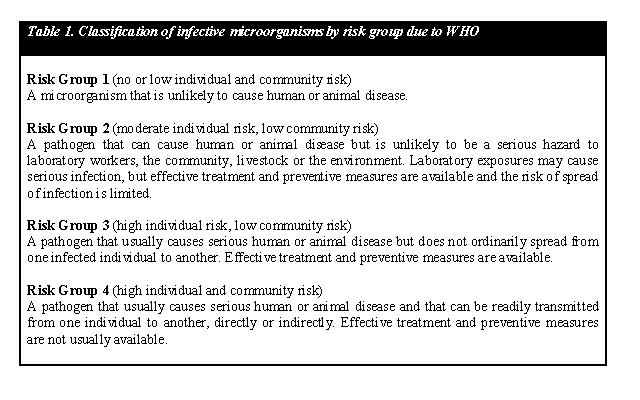Team:TU-Delft/Project/Safety/Safety-proposal
From 2011.igem.org
(Difference between revisions)
| (3 intermediate revisions not shown) | |||
| Line 33: | Line 33: | ||
By regulation we are only permitted to work in ML-1 laboratories, and as such we are aware that we will not work with hazardous and infectious host organisms and genes. Specifically, all the genes and devices that we use should be subject to regulations as given by the Dutch Government. In our faculty of Applied Sciences and more specifically in Kluyver Laboratory of Biotechnology, our team is allowed to work only in ML-1 laboratories with organisms that are categorized into Risk Group 1, and parts which are originated from non-infectious organisms, which is explained in the table below. All of them are already commercially used systems. As a result, all the parts we will construct can be considered harmless. All our ideas and plans are verified and approved by our BSO. | By regulation we are only permitted to work in ML-1 laboratories, and as such we are aware that we will not work with hazardous and infectious host organisms and genes. Specifically, all the genes and devices that we use should be subject to regulations as given by the Dutch Government. In our faculty of Applied Sciences and more specifically in Kluyver Laboratory of Biotechnology, our team is allowed to work only in ML-1 laboratories with organisms that are categorized into Risk Group 1, and parts which are originated from non-infectious organisms, which is explained in the table below. All of them are already commercially used systems. As a result, all the parts we will construct can be considered harmless. All our ideas and plans are verified and approved by our BSO. | ||
| + | |||
| + | [[File:Table 1. Classification of infective microorganisms by risk group due to WHO.JPG]] | ||
'''Researchers’ safety:''' | '''Researchers’ safety:''' | ||
| + | |||
| + | [[File: Personal-safety-equipment.jpg.gif|160px|right]] | ||
Another safety aspect that we have to be aware of is our own safety in the laboratory, the so called “researchers’ safety”. In this case, we had to verify the safety of our biological material, but also the safety of all the techniques and chemicals that we intended to use. | Another safety aspect that we have to be aware of is our own safety in the laboratory, the so called “researchers’ safety”. In this case, we had to verify the safety of our biological material, but also the safety of all the techniques and chemicals that we intended to use. | ||
| Line 46: | Line 50: | ||
Last but not least, the environmental and public safety was one of our most serious considerations. In our project, the most important issue we had to consider was the choice of the host organisms that we decided to use. | Last but not least, the environmental and public safety was one of our most serious considerations. In our project, the most important issue we had to consider was the choice of the host organisms that we decided to use. | ||
| - | The strain that we use is the E.coli strain K12, which is a specifically weakened laboratory strain. This strain is well-adapted to the laboratory environment, and unlike wild type strains, it has lost its ability to compete with natural organisms outside of the laboratory and in human organism. If it would “escape”, it would be completely unable to sustain itself without our nice little media and agar plates. Therefore our E.coli strain poses an absolute minimal threat to the public or the environment. | + | The strain that we use is the ''E.coli'' strain K12, which is a specifically weakened laboratory strain. This strain is well-adapted to the laboratory environment, and unlike wild type strains, it has lost its ability to compete with natural organisms outside of the laboratory and in human organism. If it would “escape”, it would be completely unable to sustain itself without our nice little media and agar plates. Therefore our ''E.coli'' strain poses an absolute minimal threat to the public or the environment. |
To conclude, because our project is basically targeted in fundamental and industrial purposes, the organisms are not designed to be released in the environment! The organisms are designed to be used in a closed system, which of course involve specific rules. But even in the case of using this organism as the solution for environmental problems, then it should be used out of the laboratory environment, it still can be used in a closed system. Due to the new properties of the organism, which can create controllable biofilm membranes, it has the advantage of its easy application just by strongly anchor to a surface. This makes our current contribution in synthetic biology lacking of environmental risk. | To conclude, because our project is basically targeted in fundamental and industrial purposes, the organisms are not designed to be released in the environment! The organisms are designed to be used in a closed system, which of course involve specific rules. But even in the case of using this organism as the solution for environmental problems, then it should be used out of the laboratory environment, it still can be used in a closed system. Due to the new properties of the organism, which can create controllable biofilm membranes, it has the advantage of its easy application just by strongly anchor to a surface. This makes our current contribution in synthetic biology lacking of environmental risk. | ||
Latest revision as of 10:09, 2 September 2011








 "
"









